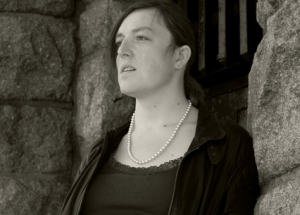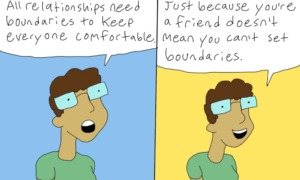Originally published on The Huffington Post and republished here with the author’s permission.
(Content Warning: Anti-gay slurs)
“How was it wrestling with the f*g? You know he’s bi, right? So fucking gross,” uttered one of the jocks.
I stood in front of my locker, immobilized.
We were in the boys’ high school locker room. On the agenda that week for Physical Education was wresting. I was paired with another boy as my wrestling partner for the week. He’d come out as bisexual sophomore year, which was a hot topic around my conservative rural school. Of course this didn’t bode well for his popularity, let alone his safety.
My 14-year-old self timidly replied, “Oh, really? I didn’t know. Nothing happened between us.” My transgressors looked at each other, unsure how to interpret my response. Did they believe me?
“If he does anything to you, let us know,” the jock said as he rolled his hand into a fist, giving me reassuring smile. They wandered back to their lockers, failing to find a reason to pick on my wrestling partner.
That was the closest I’d gotten to danger because of my sexuality as a teenager, a situation I’d go through great lengths to avoid in the future.
From that day forward, I viewed my physical attraction to men as dangerous.
I knew my wrestling partner was bi. I enjoyed wrestling with him. He did as well. We both kept quiet. That was the first time I ever had physical contact with a guy.
If this had been a John Green novel, our situation would have been a story about two quirky boys finding love and overcoming the odds to become wrestling champs for their school.
It’s not the case for many of us.
Heteronormative media romanticizes teenage relationships, but homosexual teenage relationships are largely missing or spun to look perverse. Most of our lives in school are spent hiding in the shadows for fear of our own safety.
Physical intimacy in public places, to this day, is not queer inclusive. The fact of the matter remains – queer intimacy is marked on bodies as dirty, sinful, and repulsive.
This worldview is carried inside a queer person throughout their lifetime, only to be reinforced by the fear of rejection and of physical harm. Gay men face a plethora of ensnared intimacy issues. The lack of youth LGBTQIA+ spaces, the shadow of AIDS, internalized racism, sexism, and the West’s puritan values have undermined a queer person’s self-validation and self-confidence. This can eventually lead to drug abuse, mental health problems, and poor physical health.
Stigmatization has created a pandemic in our community, endangering us all.
The London School of Hygiene and Tropical Medicine released a study showcasing why there is such a high and disproportionate amount of drug usage in gay men compared to the general population. The answer boils down to the anxieties surrounding homosexual intercourse and the perceptions of gay culture.
Social apps, like Grindr and Scruff, have helped further expose a generation of gay men to drug usage. Scroll through profiles and in no time, you’ll encounter the following: “PNP,” “Slam,” “ParTy friendly,” or “Chemsex.”
It seems easier than ever before to access drugs from the privacy of your own home through the click of a button. Men in the study reported feeling as if drug usage was a “normal” aspect to the gay scene due to the heightened visibility of usage.
However, it’s easy and popular to minimize problems to an app. Surprisingly, alcohol was reported to be the drug about which gay men expressed the most concern.
Besides LGBTQIA+ centers, there are no prevalent spaces designated for youth or sober folk to congregate. How can young gay men attain a sense of community if most places bar them from entering until they’re 21?
Gay bars have been an integral aspect of our history – just look at Stonewall. They were a place to congregate in the secrecy of the night where drinks were laid before us to ease our nerves as we chit chatted with our fellow closeted men.
Drugs always seem to go hand in hand with queer spaces, acting as a medium between men to help assuage insecurities.
So why do gay men partake in PNP, knowing full well the dangers of contracting HIV and STIs and the risk of sexual assault? Two-thirds of the men in the study reported feeling an intense, intimate connection with their sexual partner when they both were on drugs, as well as a sense of internal gratification with one’s sexuality. It gave most the opportunity to explore their sexuality in ways not “available” to them when sober.
Yet, most were aware this form of intimacy was superficial, even damaging to sustaining a relationship. Most were unhappy with their sex lives, especially those that needed drugs to engage in sex.
When pressed further, a third admitted they used drugs to overcome feelings of guilt to enjoy sex, to cope with their HIV status, to overcome rejection, or to prevail over low feelings of self-worth. Many felt pressured to take drugs just because it seemed everyone else was doing it.
Men used drugs as an excuse to engage in risky sexual behaviors. However, it’s a fallacy to assume all party drug usage equates to riskier behaviors for there were cases where drug users used condoms all the time.
The condom has become a psychological prison for queer men, reminding them of the dangers of each other’s bodies. Drugs give them the freedom to conveniently forget if they so choose.
What gave me chills were the confessions from men who were newly infected with HIV, who expressed relief. They were now free to engage in sexual activities with others in the same boat.
Gay men partake in the culture of silence, where talking about HIV is taboo. Those who do are admonished and those who don’t are in danger of contracting it. Ignorance prevails. The elephant in the room continues to sway men into taking drugs to help them ignore it.
No wonder we unconsciously see each other as dirty. We can do better as a culture to foster communication, reduce stigma, and fight back against the mainstream perception that’s slowly poisoning us.
Drugs are an excuse to be temporally okay with who you are.
Quite frankly, I can understand. When you grow up in a world where physical intimacy between queer people is rebuked, where movie ratings are upped to an R-rating solely for showing same-sex intimacy, where holding your partner’s hand in public makes you a target for assault, these reactions make sense.
On TV shows such as Will & Grace, man-on-man physical contact is hidden in order to appease the heterosexual audience. Children’s shows also lack queer representation, helping foster invisibility and shame in us at a young age.
Our stigmatization comes from within as well. LGBTQIA+ directors continue to whitewash history. The endless production of films that pander to the fear of AIDS continues to undermine one’s sexual encounters by instilling a fear of death.
When the white masculine muscular body is held up to the ideal gay man, it truly does make many of us ashamed of our own bodies and those around us. The narrative needs to change to empower our community to create spaces for better intimate encounters and to enjoy our bodies of all colors and shapes.
Queer bodies are stigmatized to the point where we cannot sustain healthy relationships. Stigma prevents access to appropriate resources, such as healthcare and counseling. Queer people are afraid of talking about their sexual behavior with their own doctors and therapists.
My first doctor critiqued me for my behavior, despite my having practiced safe sex. How can we explore and remedy such an integral aspect of ourselves if we are so afraid and ashamed?
We’re still running. It’s time to stop. As a community when we band together we can overcome so much. Our movement didn’t end with marriage equality.
It will continue for decades to come, but now it’s time to save ourselves so that we can create a better world for our future LGBTQIA+ youth. We can make an AIDS and HIV free generation a reality, one that has access to sound mental health, safe spaces, and inclusion. I encourage you to help make drug-free queer spaces, promote more inclusive visibility in our media, and finally just work towards these goals with each other.
[do_widget id=’text-101′]
Joel Alcaraz was born in Mexico, raised in small town USA, and grew up in an underprivileged area working in the camp alongside his father as a undocumented child. He managed to graduate as Valedictorian and was accepted into UCLA. There he majored in Anthropology and realized his passion for helping and understanding others by using creative writing and events. Joel has worked for various companies such as Disney, Nickelodeon, Participant Media, UP Global, and now Techstars. Joel continues to advocate for positive changes in the world for disadvantaged people across complex intersectional systems.
Search our 3000+ articles!
Read our articles about:
Our online racial justice training
Used by hundreds of universities, non-profits, and businesses.
Click to learn more





















